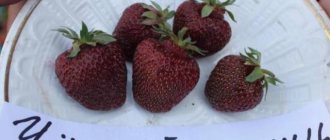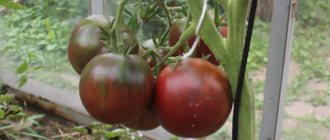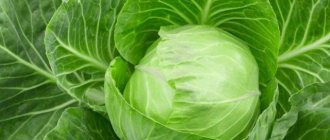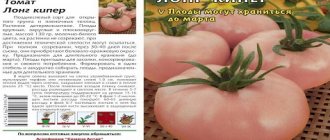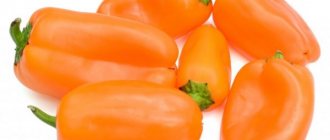Characteristics table
Strawberries “Black Prince” were bred for the mild conditions of Italy, so the description of the variety from the originator does not always correspond to reality. But the basic characteristics of culture remain unchanged.
| Parameter | Characteristic |
| Ripening period | Mid-early |
| How many times does it bear fruit per season? | Once, not reusable |
| Yield per bush | High: up to 1 kg |
| Berry size | Medium and large |
| Form | Truncated or rounded conical |
| Color | Dark red, cherry |
| Taste qualities | The berries are sweet, with a slight sourness |
| Aroma | Weak |
| Pulp | Juicy, dense, without voids |
| Purpose of the variety | Universal |
| Drought resistance | Low |
| Frost resistance, winter hardiness | Up to -30 °C under cover, up to -15 °C without shelter |
| Disease resistance | Resistant to major strawberry diseases and mites, spotting may appear in the fall. |
| Transportability of berries | 4.7 out of 5 points |
| Life cycle | 7 years |
| Tasting assessment | 4.8 out of 5 points |
Advantages and disadvantages
Like any other strawberry variety, with a large number of advantages, the Black Prince is not without some disadvantages, which should definitely be taken into account before planting plants on the site.
- The list of advantages of the described strawberries includes the following characteristics:
- excellent commercial quality and good taste of the fruit;
- high transportability and the ability to store berries for up to two weeks, without losing their quality;
- high resistance to strawberry diseases and pests, which greatly simplifies plant care;
- relatively high yield of the variety;
- the possibility of growing in the middle zone without shelter (provided that winter temperature drops do not exceed -20°C);
- long-term fruiting (for 7 years without reducing the abundance of the harvest).
There are much fewer disadvantages of the variety and for the most part they are relevant for the northern regions of Russia. Strawberries do not grow well in harsh conditions, so to obtain a high yield, it is better to grow them in greenhouse conditions. We should not forget about the demanding nature of the variety in terms of watering: prolonged drought will negatively affect not only the abundance of fruiting, but also the quality of the berries.
Detailed description of the variety
Strawberry "Black Prince" is not remontant. It produces berries once per season, fruiting is extended. The fruits are attractive, do not wrinkle or flow during transportation. Suitable for fresh consumption, making compotes and jam. Withstands storage with rapid cooling for 10–12 days.
Productivity
Medium-early ripening variety, productive. The first berries appear at the end of June, fruiting lasts until mid-August. If you follow the standard rules of agricultural technology, you can collect up to 1 kg of berries from one bush.
Peak yields occur in the 2nd, 3rd and 4th year after planting. Further, the indicator decreases, but the strawberries will still bear fruit consistently until the 7th year of life.
Characteristics of berries and bush
The name of the variety “Black Prince” is associated with the characteristic color of the berries. After full ripening, they acquire an unusual, almost black hue, by which the fruits can be immediately distinguished from another variety.
Young bushes are small in size, compact, but over time they grow greatly.
Adult plants of the “Black Prince” are taller than other varieties of strawberries (reach 30 cm), so more space needs to be left when planting. The leaves are dark green, glossy. Peduncles are located above the leaves, but under the weight of the fruits they can lie down.
The taste of the berries is pleasant; according to most gardeners, it is sweet, with or without barely noticeable sourness. The pulp is dense, without voids, thanks to which the strawberries are well stored and can easily withstand long-term transportation. The seeds are large, dense, and stand out on the surface.
Advantages and disadvantages
Strawberries "Black Prince", like any garden crop, have advantages and disadvantages.
pros:
- excellent taste;
- original look;
- large berries;
- long fruiting;
- tolerate transportation well;
- stable yield;
- satisfactory winter hardiness;
Minuses:
- by autumn and in unfavorable years the berries become smaller;
- low drought resistance;
- mature bushes take up a lot of space.
- the achenes crunch on the teeth.
What regions is it suitable for?
The winter hardiness of the Black Prince variety is average. The description states that the bushes can withstand up to -30 °C under cover. Therefore, this variety can be grown in most regions of Russia:
- Volga region;
- Chernozem region;
- North-West (Leningrad region);
- Center of Russia (Moscow and Moscow region);
- Ural;
- south of Siberia.
Without shelter for the winter, “Black Prince” strawberries can be grown in the Krasnodar Territory, the North Caucasus and neighboring regions.
The “Black Prince” variety does not tolerate drought well and requires regular watering in hot weather. Gardeners living in regions with insufficient moisture should take this into account.
Description and characteristics of strawberry Black Prince
When assessing the qualities of a particular strawberry variety, attention is first paid to the characteristics of the berries, but the characteristics of the plant’s bushes are often left without due attention. In order to make an accurate assessment of the selected strawberry, it is important to take into account all its features, characterizing both the fruit and the above-ground part of the crop as a whole. True, for convenience, you can still divide the set of available qualities into two main groups of descriptions.
Important! The tendency of the variety to reduce the number of emerging runners should be taken into account when growing strawberries for seedlings, because without updating the plantings over time, you can be left without young plants of the crop.
Bush
Black Prince is a medium-sized strawberry variety, the above-ground part of which is characterized by increased resistance to various adverse environmental factors. The bright green leaf blades of the bushes are medium in size, have a glossy surface and create moderate thickening of the plantings. During the season, one plant forms a moderate number of medium-thick tendrils, however, with each year of cultivation their number decreases, which cannot be said about the abundance of fruiting.
Fruit
The Black Prince strawberries are distinguished by a very dark color , so the name of the variety can be considered quite justified. The surface of the skin is covered with a large number of seeds, which is why the fruit appears a little prickly or rough. In shape, all strawberries resemble a truncated cone , and under the medium-thick skin there is bright red dense pulp with an attractive sweet and sour taste.
There are no white veins or voids in it, which only increases the value of the fruits of this variety of strawberries. The weight of one berry ranges from 35–50 g , so even with a small planting area there is every chance of getting a large amount of tasty harvest.
Best place for strawberries
Strawberry "Black Prince" prefers warm, sunny areas with loose soil
Strawberry "Black Prince" grows well in dry, wind-protected areas located in the sun. It prefers loose, nutritious soils, so a month before planting it is recommended to dig up the ridges and cover them with compost or humus in an amount of 5–7 kg per 1 m2.
If the soil is too dense, 1 kg of sawdust or sand is added to the same area.
When planning plantings, choose places where legumes, radishes, radishes, mustard, garlic or parsley used to grow. Bad predecessors and neighbors for the Black Prince strawberry: cucumbers, tomatoes, potatoes, sunflowers and all representatives of the Buttercup family.
Site preparation
The ideal option is to choose a site in the fall, dig it up and add mineral fertilizers to the soil. But this does not mean that you will have to give up planting if the decision to plant berries came only in the spring.
We choose a suitable place and a few weeks before planting (1-2 months) we dig up the soil onto the bayonet of a shovel, enrich it with organic substances (humus, manure, humus). At the same time, it would be good to think about weed protection. Treating the soil with herbicides can help.
How to choose good strawberry seedlings
You can purchase “Black Prince” strawberry seedlings in special stores, as well as in online stores. When purchasing, you should pay attention to reviews about the supplier. If possible, carefully inspect the seedlings.
Requirements for healthy seedlings:
- leaves are green, without spots, plaque, or damage;
- stems are juicy and elastic;
- roots without rot, at least 8 cm long.
If strawberry seedlings are in pots, the root system may extend beyond the container.
How to care
To get a bountiful and high-quality harvest, you need to properly care for your plantings. This strawberry variety is moisture-loving. Therefore, the soil should not be allowed to dry out and remain in this state for a long time.
You also need to ensure that water does not stagnate in the soil, otherwise putrefactive processes cannot be avoided. It is best to water once a week. Experienced gardeners recommend installing a drip irrigation system.
To get a good harvest, you need to periodically feed the bushes. In spring, fertilizers containing nitrogen are applied. During the period of inflorescence appearance, phosphorus-potassium fertilizing is necessary. When the crop is harvested, organic fertilizers should be applied.
Periodically you need to inspect plants for diseases and pests. Despite the strong immunity, sometimes strawberries of this variety are affected by verticillium and white spot.
In most cases, this is due to improper care and water stagnation. The most common pests are aphids and mites. If symptoms of their vital activity are detected, it is necessary to take timely measures.
Features of landing and the best way
For the “Black Prince” strawberry variety, 2 rooting periods are suitable: late spring (second half of May) and autumn, a month before the first frost.
Since bushes grow greatly with age, it is worth choosing a two-line planting scheme, leaving 35–40 cm between seedlings and 80–90 cm between rows.
How to plant “Black Prince” strawberries correctly:
- Mark the holes.
- Place the seedlings overnight in Kornevin (10 ml solution per 10 l) or another growth stimulator solution.
- Plant in the center of the hole and spread out the roots.
- Sprinkle with soil and tamp lightly, leaving the root collar above the ground.
- Pour 0.5 liters per bush, mulch with sawdust, hay, and pine needles.
In the Urals and Siberia, it is better to plant strawberries in mid-to-late August.
Read more about how to plant strawberries in spring, summer and autumn →
The history of the appearance of the Black Prince variety
The garden strawberry variety Black Prince was obtained in the nursery. This company is one of the producers of high quality planting material in Italy. The work of breeders from Cesene lasted ten years, the variety was tested in Ukraine and has proven itself well in Europe, as well as in many regions of Russia and Kazakhstan.
However, in some sources, early garden strawberries of the Polish selection Kama are passed off as this variety, which, due to its dark cherry berries, began to be incorrectly called the Black Prince.
Features of care
The strawberry variety “Black Prince” is not demanding in terms of care. The basic rules of agricultural technology are standard - regular watering, fertilizing, loosening, weeding and pruning.
Watering
Regular watering is the key to a good strawberry harvest.
The “Black Prince” variety is demanding on moisture, so water must be given at least once a week. If there is a long drought, water every three days, making sure that the surface layer remains only slightly moist. The water consumption rate is from 10 to 20 liters per 1 square meter.
After heavy watering or heavy rain, the soil needs to be loosened. This way the roots will receive more oxygen and there will be fewer weeds.
Top dressing
Fertilizers for strawberries “Black Prince” are applied 3-4 times per season. Since the variety is characterized by longevity and stable fruiting, it is recommended to increase the fertilizing rate.
| When to feed strawberries | What and how |
| After the snow melts | Scatter urea granules - 50–70 g per 1 m2 |
| Late May (blooming) | Pour 500 ml of wood ash infusion (200 g per 10 l) per bush |
| Beginning of June (formation of the first ovaries) | Feed with mullein infusion (1:10) 500 ml at the root |
| August-early September (after harvest) | Scatter dry mullein (3 kg per 1 m2) + 30 g of any complex fertilizer under the bush over the area |
Agronomists recommend feeding with Kemira fertilizers or EM concentrate once every 10 days after the first flower stalk appears.
Reproduction
Strawberry "Black Prince" produces a lot of whiskers, some of which are used for propagation. At the end of May or early June, cuttings from first-year bushes are added in drops and watered regularly. After the roots appear, the tendrils are separated from the mother plant and planted for growing or transferred to a new site.
If the variety is propagated by dividing the mother bush, the resulting rosettes are immediately rooted in another place. They are cared for like adult plants, but watered more often.
Trimming
Strawberries of the "Black Prince" variety are pruned as needed - the tendrils, peduncles are removed, and in the fall - the entire above-ground part. If plaque, spots and other signs of disease appear on the leaves, all affected plants are immediately removed and burned.
Read more about the necessary processing of strawberries in the fall →
Preparing for winter
The Black Prince variety requires good shelter in most regions. To do this, at the end of October, when the temperature is stably below 0 ° C, the plantings are mulched with a high (10–12 cm) layer of straw, hay or sawdust. In the Urals and Siberia, an additional frame is installed, and dense agrofibre or burlap is stretched over it.
Mulch and frame should be removed gradually, from March to mid-April. Otherwise, the bushes may overheat and die.
Transfer
Strawberries of the Black Prince variety have a long life cycle. Even without rejuvenation, it bears fruit consistently for 6–7 years in a row. Therefore, it is not necessary to replant every 3–4 years.
Landing technology
Before planting Black Prince strawberries, it is important to select the optimal timing for completing the procedure and properly prepare the planting site , taking into account all the requirements of a particular crop. Each preparatory event, like the planting technology itself, has its own characteristics, which is always worth remembering to obtain the most positive result.
How to choose the right seedlings
Choosing strawberry seedlings is one of the first and most important tasks , because low-quality seedlings will not be able to bear a large number of tasty fruits. Plants of the Black Prince variety suitable for planting should always be tall, with dense and wide leaves, as well as strong mustaches.
For a small seedling, their number may not exceed 2-3 pieces, but they must all be dense, without signs of disease or pest activity. There should be no damage to other parts of the plant, otherwise successful adaptation of the young plant to the site cannot be guaranteed.
When and where to plant berries
The best time to plant Black Prince strawberry seedlings is mid-September , however, residents of southern regions with hot summers can begin the task as early as May. The optimal layout for strawberry bushes is 40x50 cm (the distance between neighboring plants in a row and the rows themselves). For branchy and lush bushes of the described crop, this distance will be quite enough for comfortable growth and development.
The place where strawberries are planted should be well lit and warmed by the sun's rays, but the appearance of cold winds in this area is extremely undesirable, especially soon after planting the seedlings. The optimal level of groundwater is no closer than 60 cm to the surface of the substrate, otherwise, due to constant humidity, the root system of plants will begin to rot. Given this possibility, it is not recommended to plant strawberries in low-lying areas and on steep slopes, where all the water will flow down.
The optimal type of soil mixture at the planting site is gray forest substrates or light loamy soils . Heavy clay and peat soils are not suitable for growing strawberries, because even with a good drainage layer, the rhizome will still rot. If chernozem soils predominate on the site, then when organizing a planting hole, it is worth adding sand to the ground.
During the autumn preparation of the selected area, the soil is fertilized with humus , adding organic matter for digging at the rate of 5 kg per 1 m² of territory. If the soil is highly acidic, additional dolomite flour or lime is added, and for 1 m² only 200–300 g of the selected substance will be sufficient. Of course, all plant debris and weeds must be removed.
Important! The best predecessors for Black Prince strawberries are legumes, cereals, as well as onions and carrots. After eggplants, cabbage, tomatoes and potatoes, you should not plant strawberry seedlings.
Planting in open ground
As soon as the soil in the prepared area settles a little, and the fertilizer is evenly distributed throughout the entire thickness of the soil, it will be possible to proceed to direct planting measures.
The algorithm for performing all actions in this case will look like this:
- According to the recommended placement scheme for strawberries, dig holes for young plants (the width of the hole should be at least 20 cm, with a depth of 10–15 cm).
- Moisten each hole well with water and wait until the liquid is completely absorbed into the soil.
- Take the Black Prince seedling and place it in the hole strictly vertically, straightening the roots (they should not bend or get tangled).
- Carefully cover the rhizome with soil, making sure that there is no air space between adjacent roots.
- At the end of the process, the soil around the planted bushes should be compacted again and watered well.
After completing the planting procedure, the growth point of the bush (resembles a heart) should be above the ground surface. Excessive deepening of plants or planting strawberry plants too high on the site will lead to damping or drying out of the plants.
Important! It is good if Black Prince strawberries are planted in the evening or in cloudy weather, when sun activity is minimal. This is especially true during spring planting, which is explained by the tendency of the roots to dry out when exposed to sunlight.
Pests and diseases
The Black Prince variety has good immunity to common diseases. But with improper care (excessive watering, unbalanced fertilizing) and against the backdrop of a rainy summer, it can suffer from root rot and powdery mildew.
As a preventive measure, in early April it is recommended to carry out 1-2 treatments with fungicides (consumption per 10 l):
- Abiga-Pik - 50 g;
- HOM - 40 g;
- Fitosporin - 15 ml;
- Speed - 4 ml.
Strawberries can also be attacked by aphids, spider mites and other pests. To combat them, insecticides and acaricides are used (consumption rate per 10 l):
- Vertimek - 5 ml;
- Kleschevit - 10 ml;
- Agravertine (Akarin) – 20 ml;
- Biotlin - 5 ml.
Harvest and storage
If you are going to eat fresh strawberries or use them for processing in the near future, then you need to pick them at the stage of full ripeness: around the end of June or beginning of July, depending on the growing region. In the event of future long-term transportation of the harvested crop, it is better to remove the fruits from the bushes slightly unripe, so that they have 4–5 days before full ripening. Such berries usually have a lighter color, closer to pink.
The optimal time for harvesting strawberries is in the morning, shortly after the dew has dried . When harvesting by hand (the use of machines for harvesting work on strawberry plantations is not recommended) the tail must remain with the berry, otherwise the pulp will quickly spread. If possible, the harvested crop should be immediately packaged in containers for transportation, which are often presented in the form of wooden boxes with a volume of no more than 2–3 kg. The berry layers are covered with food paper, after which the container is sent to the cellar shelves for short-term storage.
Learn how to grow strawberries in winter.
A small amount of strawberries can be successfully stored in the refrigerator, on fruit shelves, however, there should not be bananas, pears or any other fruits that actively release ethylene nearby. Before placing strawberries in shipping containers, they must be disinfected with a strong solution of potassium permanganate, and then left until the liquid dries completely.
Black Prince strawberries are a worthy representative of mid-early varieties of the crop, and given the relatively low requirements for care and the possibility of growing over a large territory of the Russian Federation, it is not surprising that these berries are loved by many gardeners, and the plants themselves are increasingly found in summer cottages.
Possible problems
In general, growing Black Prince strawberries does not cause any big problems. But beginning gardeners often make the same mistakes, which reduce productivity. Therefore, we recommend paying attention to the following points:
- The “Black Prince” bushes are spreading, which means planting closer than 40 cm is excluded. Otherwise, the plants will not have enough light, the berries will be crushed, and the risk of pests will increase.
- Large fruits often fall to the ground. To prevent rotting, you need to lay agrofibre or mulch.
- Due to drought, the leaves lose their elasticity and begin to wither. At this point, increased watering is required.
The Black Prince variety is interesting for its unusual berries with a pleasant taste. The fruits are large, the pulp is juicy and dense. Therefore, they can be grown for yourself and for sale. Stable yields and a long life cycle will ensure profitability of production.
Reviews from gardeners
Natalya Vladimirovna, Sumy, 53 years old.
I have known the Black Prince for several years. I grow this variety for sale on the market, so I can fully describe all its characteristics. I'll start with taste. Excellent. This is the first variety on the market. They sort it out the fastest. When the Black Prince ends, they begin to sort out another berry. The ripe fruits of the Black Prince are really very tasty. Now transportability. Very good if you don't overfill the strawberries. It is also stored for a long time, approximately 10-12 days, but this is if the berries are cooled. In terms of ripening time - average, at the end of the growing season we do not get smaller. In general, we keep it in one place for about 5 years, during which time it does not lose its qualities. In the 4th year, the bushes almost completely stop forming mustaches. I really like the variety. Maybe it’s not that productive, but the demand on the market is just crazy.
Vladimir Igorevich, Rostov, 41 years old.
Excellent variety. The berry is very beautiful and tasty. The yield is also good. Now I grow only 2 varieties, Clery and Black Prince. I spent a long time selecting varieties until I settled on these and have no intention of changing them.
Alexandrina
There are two varieties with this name: small-fruited remontant strawberries and large-fruited berries originally from Western Siberia, which will be discussed. This strawberry was obtained in Altai at the end of the 20th century and was included in the State Register in 2009.
The main advantages of the variety:
- excellent frost resistance;
- resistance to strawberry mite;
- berry evenness;
- high self-fertility.
The ripening period is medium late. The bushes are tall, dense, semi-spreading. The mustaches are numerous, the seedlings are strong. The rounded, flattened, kidney-shaped fruits weigh from 9 to 30 g. The ripe berries are purple-cherry. The pulp is medium dense, sweet and sour, fragrant. Fruit tasting score – 4.2 points; In jam the berries become jelly-like. The yield of the variety is average, resistance to gray fruit rot is from strong to moderate.
Growing seedlings
To plant a berry garden, planting material purchased from nurseries or obtained independently is used.
Preparatory work
Sowing begins at the end of winter. If you do this earlier, then there will not be enough natural light for full-fledged shoots to appear. Additional illumination will be required to increase the duration of daylight up to 12 hours.
In order for strawberry seeds of this variety to show good germination, stratification is carried out. Sequencing:
Strawberry with pineapple flavor
- Take a plastic container with cotton fabric placed at the bottom.
- Seed material is distributed over it.
- Moisten it with a spray bottle and cover it with the same cloth.
- Close the container with a lid in which holes are made.
- Leave it warm for 2 days, then put it in the refrigerator for 14 days (in the vegetable compartment).
- During this time, monitor the condition of the seeds and, if necessary, moisten them.
At the same time, they begin to prepare the soil so that after disinfection, beneficial microorganisms have time to multiply in it. A substrate for strawberries is prepared that is fertile and has a high level of breathability. Take an arable layer of garden soil and sand in a ratio of 1:2.
The soil is calcined in the oven for 20 minutes at a temperature of 200 °C
Sowing seeds
Since strawberry seeds of this variety are small, it is better to sow them in one container for seedlings, and then pick the seedlings. Progress:
- The box is disinfected with a manganese solution.
- Expanded clay is distributed along the bottom as a drainage layer.
- Pour soil on top, level it, and lightly compact it.
- Small indentations (0.5 cm) are made at intervals of 3 cm.
- Lay out the seeds, sprinkle with soil and moisten with a spray bottle.
The emergence of seedlings is noted after 15-20 days. If the temperature is within 25 °C, sprouts may appear earlier
Caring for strawberry seedlings
Strawberry seedlings are grown in a well-lit room. It should be warm. The crops are regularly moistened so that the soil remains moist, but the liquid does not stagnate in it. The water used is heated and settled. Pour directly under the root, not over the leaves. Failure to comply with the last rule often provokes the development of fungal diseases.
After the formation of the second pair of leaves begins, the seedlings are planted in separate pots. Diameter - 5-7 cm. It is better to use peat pots, since strawberries are planted in them directly into the ground without disturbing the root system. A month before transplanting to the site, the saplings are hardened. Every day, the plants are briefly transferred to a cool room, gradually increasing the time they stay there. In the last 2-3 days before planting, the planting material is left at a temperature of 5 °C overnight.
Strawberries or strawberries?
Garden and wild strawberries; Meadow, steppe and garden strawberries belong to the genus Strawberry, the Rosaceae family. Despite this, strawberries and wild strawberries differ in both appearance and place of growth.
Strawberries have highly corrugated leaves. The peduncle is tall, erect, the berries rise above the leaves. The shape of the berry is spherical. The name strawberry comes from the old Russian “klub” (tangle) - round, spherical. Strawberries grow in the steppes, meadows and forest glades, that is, in open sunny areas.
Strawberries are located above the leaves and have a spherical shape.
Wild strawberries, on the contrary, grow in the forest, their leaves are smoother and darker, their flower stalk is shorter, and the berries are located close to the ground. For this feature, the plant received its name, which comes from the Old Russian “strawberry”. The shape of the berry is complex, assembled, often conical.
Garden strawberries have the same features as their forest relatives, but they are much larger and more productive. One of the first varieties of garden strawberries in Russia (Victoria) was obtained by hybridization of two American species. There is no such berry in the wild.
The berries of garden strawberries are large; under their weight, the peduncle bends to the ground
Venta
The mid-early berry of the Baltic (Lithuanian) selection is a hybrid of the famous varieties – Festivalnaya and Zenga-Zengana. Plants are practically not affected by powdery mildew. The height of the bushes and spreading are moderate, the fruitfulness is high. The average weight of the berries is 12 g, but the first fruits in clusters are twice as large. The shape is a blunt cone, with a small neck. The surface is smooth, glossy, crimson-red. The pulp is juicy, excellent sweet taste with a spicy, aromatic sourness. Among the disadvantages of the variety, mention should be made of susceptibility to gray fruit rot.
